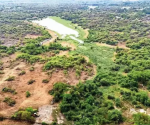AP seafood industry in tariff turmoil

Visakhapatnam: Nearly 2,000 containers of seafood – about 30% of which come from Andhra Pradesh – are currently en route from India to the US. Another 2,000 containers are being prepared for shipment.
With the US set to impose a 26% tariff on a range of Indian goods including seafood, Indian exporters now face the daunting task of absorbing an estimated Rs 600 crore in tariffs for these shipments in transit worth around Rs 2,000 crore, if they do not reach US shores before April 9, when the new tariffs come into effect.
Indian seafood exporters operate under the ‘delivered duty paid’ (DDP) model when exporting to the US. Under the arrangement, exporters are responsible for all costs, including shipping, insurance, and import duties, until the goods are delivered to the buyer’s location.
This effectively makes Indian exporters the ‘importers’ in the US, as they handle the payment of duties and tariffs. Any increase in tariffs would have to be borne by them.
Andhra Pradesh, which contributes about 32% of India’s total seafood exports and generates roughly $2 billion to $2.5 billion in revenue, is expected to bear the major brunt of this development. The ripple effects are likely to impact a broad spectrum of industry stakeholders, ranging from farmers and fishermen to hatcheries and exporters.
This measure is likely to affect both short-term logistics and long-term pricing strategies, according to marine products exporters. Specifically, the shrimp farming sector, a major contributor to Andhra Pradesh’s seafood exports, could face financial stress, potentially leading to reduced production and job losses in the region.
Speaking to TOI, Pawan Kumar G, president of the Seafood Exporters’ Association of India, said Indian exports will incur tariffs of 26%, while competing countries such as Ecuador, Vietnam, and Indonesia face tariffs of 10%, 46%, and 32%.
“This gives Ecuador a substantial advantage, making it likely that they may replace India as the largest supplier of shrimp to the US market. Given the prevailing margins in this sector are only 4–5%, it will be extremely difficult for Indian seafood exporters to absorb this margin difference of 16% compared to Ecuador. In addition to the tariff announced on April 2, there is a 5.77% countervailing duty imposed by the US department of commerce on all shrimp exports. The US has also initiated an investigation into the imposition of an anti-dumping duty, the full quantum of which is yet to be determined,” said Pawan Kumar.
Meanwhile, officials from the Marine Products Export Development Authority (MPEDA) informed TOI that discussions would be initiated with relevant authorities and stakeholders to address these concerns.
Andhra Pradesh, with its nearly 1,000-kilometre coastline, has long been a powerhouse in marine production. Over the past three to four decades, aquaculture has revolutionised the state’s agricultural landscape, with aquaculture now being practiced on about 4 lakh acres. Fishing and aquaculture sector’s contribution to state GVA (gross value added) expanded from about 4% in 2014-15 to over 8% in 2024-25.
TDP Narasaraopet MP Lavu Sri Krishna Devarayaulu said, “The state’s seafood sector contributes 11% to its GDP. I urge the intervention of the commerce minister to secure fair trade terms and initiate policy adjustments to protect farmers and ensure the industry’s global competitiveness.”
Arjili Dasu, general secretary of the Federation of Indian Fisher Organisations, a national organisation representing the fishermen community, said, “Due to the tariff increase, the quantum of exports will be affected, and ultimately, pricing will be disrupted, adversely impacting the fishermen community,” said Dasu.
With the US set to impose a 26% tariff on a range of Indian goods including seafood, Indian exporters now face the daunting task of absorbing an estimated Rs 600 crore in tariffs for these shipments in transit worth around Rs 2,000 crore, if they do not reach US shores before April 9, when the new tariffs come into effect.
Indian seafood exporters operate under the ‘delivered duty paid’ (DDP) model when exporting to the US. Under the arrangement, exporters are responsible for all costs, including shipping, insurance, and import duties, until the goods are delivered to the buyer’s location.
This effectively makes Indian exporters the ‘importers’ in the US, as they handle the payment of duties and tariffs. Any increase in tariffs would have to be borne by them.
Andhra Pradesh, which contributes about 32% of India’s total seafood exports and generates roughly $2 billion to $2.5 billion in revenue, is expected to bear the major brunt of this development. The ripple effects are likely to impact a broad spectrum of industry stakeholders, ranging from farmers and fishermen to hatcheries and exporters.
This measure is likely to affect both short-term logistics and long-term pricing strategies, according to marine products exporters. Specifically, the shrimp farming sector, a major contributor to Andhra Pradesh’s seafood exports, could face financial stress, potentially leading to reduced production and job losses in the region.
Speaking to TOI, Pawan Kumar G, president of the Seafood Exporters’ Association of India, said Indian exports will incur tariffs of 26%, while competing countries such as Ecuador, Vietnam, and Indonesia face tariffs of 10%, 46%, and 32%.
“This gives Ecuador a substantial advantage, making it likely that they may replace India as the largest supplier of shrimp to the US market. Given the prevailing margins in this sector are only 4–5%, it will be extremely difficult for Indian seafood exporters to absorb this margin difference of 16% compared to Ecuador. In addition to the tariff announced on April 2, there is a 5.77% countervailing duty imposed by the US department of commerce on all shrimp exports. The US has also initiated an investigation into the imposition of an anti-dumping duty, the full quantum of which is yet to be determined,” said Pawan Kumar.
Meanwhile, officials from the Marine Products Export Development Authority (MPEDA) informed TOI that discussions would be initiated with relevant authorities and stakeholders to address these concerns.
Andhra Pradesh, with its nearly 1,000-kilometre coastline, has long been a powerhouse in marine production. Over the past three to four decades, aquaculture has revolutionised the state’s agricultural landscape, with aquaculture now being practiced on about 4 lakh acres. Fishing and aquaculture sector’s contribution to state GVA (gross value added) expanded from about 4% in 2014-15 to over 8% in 2024-25.
TDP Narasaraopet MP Lavu Sri Krishna Devarayaulu said, “The state’s seafood sector contributes 11% to its GDP. I urge the intervention of the commerce minister to secure fair trade terms and initiate policy adjustments to protect farmers and ensure the industry’s global competitiveness.”
Arjili Dasu, general secretary of the Federation of Indian Fisher Organisations, a national organisation representing the fishermen community, said, “Due to the tariff increase, the quantum of exports will be affected, and ultimately, pricing will be disrupted, adversely impacting the fishermen community,” said Dasu.
















